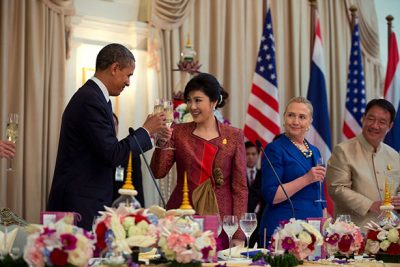But domestic constraints and persistent problems in the Middle East, South Asia and elsewhere will hinder the United States’ ability to manoeuvre in Asia. The rebalancing is a smart strategy, but America’s resource constraints and geographical challenges will be its long-term spoiler.
The focus of the visit was mainland Southeast Asia, a sub-region that is pivotal to America’s pivot. America, a sea power with vast continental resources, wants to reclaim its place in a different fashion than when it was last there, during the Indochina wars of the last century. China has always been present in Southeast Asia geo-strategically, their historical influence having spanned centuries. The states that make up the region have hedged between the two giants.
Obama’s first stop was Bangkok. This is unsurprising, as Thailand is a friend of 180 years and was a treaty ally through the Cold War. He then headed to Yangon in symbolic support of Myanmar’s reform momentum. His Yangon visit was designed to propel the democratic transition in what Obama’s predecessor labelled an ‘outpost of tyranny’. The Obama presence in Myanmar was the first step toward making up for years of sanctions, which placed the US government and private sector behind the curve, while China and ASEAN made deep inroads. Phnom Penh was the final stop, for the increasingly important strategic dialogue between the 18 members of the East Asia Summit.
Underpinning the Obama visit is the United States’ relatively small but symbolically significant US$50 million Lower Mekong Initiative, which aims to assist in infrastructure development and capacity building in mainland Southeast Asia. But despite this assistance, mainland Southeast Asia is increasingly leaning toward Beijing’s orbit in a new formation that can be referred to as ‘CLMT’ — Cambodia, Laos, Myanmar and Thailand.
A generation ago, the mainland half of ASEAN was known as the ‘CLMV’ — ‘V’ being Vietnam. But the conflict in the South China Sea, where China’s aggressive role is fiercely resisted and America’s presence is warmly welcomed by the ASEAN maritime states, has set Hanoi apart. At the same time, Thai ties to China have warmed inexorably. For example, Thailand’s position on the South China Sea has been that it is beyond the scope of ASEAN as a whole and should be settled bilaterally.
China and Vietnam have cooperated at the highest levels on trade, investment and diplomacy, but their rift in the South China Sea has trumped the bilateral relationship. The Philippines is even more confrontational vis-à-vis Beijing, and has leaned on the United States for backing and reassurance. The same might be said of other nations wary of China’s intentions in the contested seas, including Japan, Australia, Malaysia and Indonesia. Through a new system of bolstered treaty alliances and strategic partnerships, the United States’ role and its maritime power is challenging Beijing’s dominance in maritime Southeast Asia.
Moreover, the interests and concerns of the maritime Southeast Asian states are increasingly divergent from those of CLMT. CLMT were either silent or supportive of Cambodia’s pro-China stance at the annual regional ministerial meeting in Phnom Penh in July 2012 (the meeting at which ASEAN failed to produce a joint statement due to the insistence of the Philippines and Vietnam on including language on the South China Sea disputes).
It appears that maritime Southeast Asia is increasingly leaning toward Washington, whereas mainland Southeast Asia is more influenced by Beijing.
Obama’s presidential foray should not set out to antagonise Beijing. China and the United States have significant relations and strong commercial ties. China is America’s largest creditor and America is China’s largest export market. Such cooperation is preferable to open rivalry.
Regional discussions and meetings on peace and stability in Cambodia should thus focus on regional architecture. The discredited notion of a G2, whereby Beijing and Washington would together dictate regional outcomes, should be revisited up to a point. A working regional framework must rely on mutual understanding and accommodation. The ASEAN states have more to gain from partial implementation of the G2 than a complete rivalry between the two superpowers.
If China moderates its South China Sea claims and the United States reassures Beijing that its rebalancing toward Asia is benign, maritime and mainland ASEAN states would not be caught between the two superpowers. Southeast Asia could then be a source of security and stability for all of Asia.
Thitinan Pongsudhirak is Director of the Institute of Security and International Studies, Faculty of Political Science, Chulalongkorn University.


The US romancing SE Asia is perceived by China as another concerted attempt to contain and isolate China.